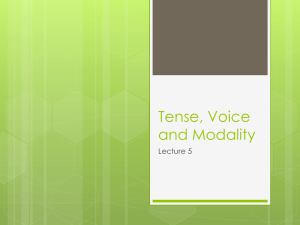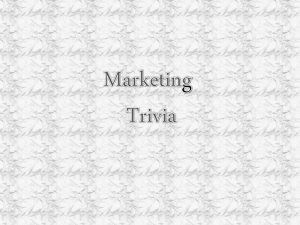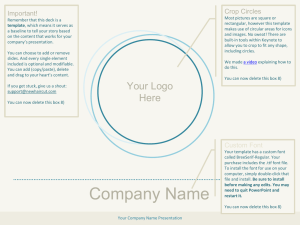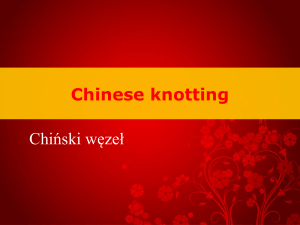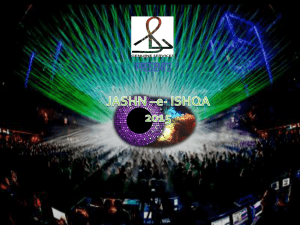to lecture slides - Mathematics and Mathematics Education
advertisement
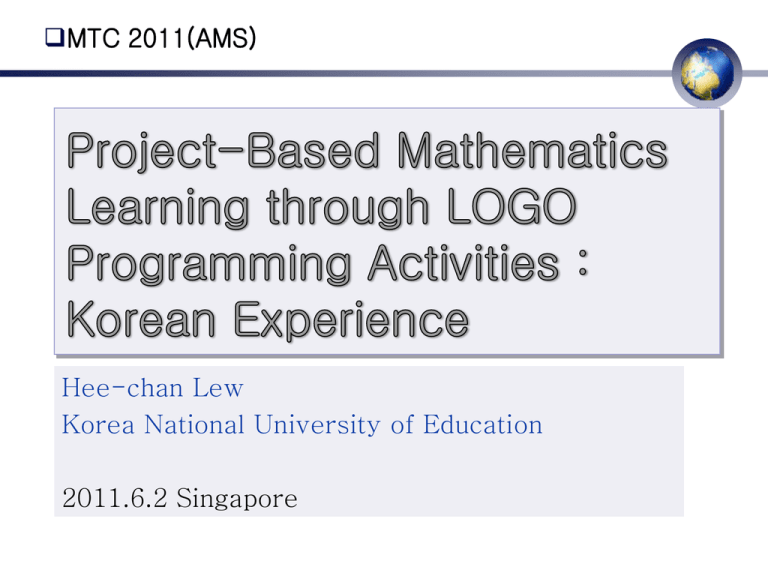
MTC 2011(AMS) Hee-chan Lew Korea National University of Education 2011.6.2 Singapore Contents Background of This Lecture The Characteristics of LOGO for Projectbased mathematics learning Concepts and Characteristics Role for mathematics education Project-based Mathematics Learning through LOGO activities Overview & Methodology Tasks & Activities Results Conclusion Background Background LOGO was developed 30 years ago, in 1980 by S. Papert. It is very old software. But, why today? It is a good environment suitable for today’s conference theme: Communication, Reasoning & Connections communication among teachers and students inductive & deductive reasoning connection between mathematics and other subjects like art, geometry and algebra, and old action(thinking) and new action(thinking) Background Why LOGO was chosen as my research topic? It is a good environment for pursuing mathematics educational objectives Korean Government has emphasized currently. For example, mathematics education policy issued by Korean MEST, May 17, 2011. Emphasizing connection between mathematics and other subjects like Science, Technology, Engineering, and Art. (STEAM) Inducing positive image of students and public toward mathematics by designing more interesting action-based mathematics education Background Training creative manpower through integrated thinking/reasoning and problem solving ability Constructing democratic society through reasonable communication in mathematics classrooms Today, I will introduce LOGO as a good environment suitable for current common concerning of mathematics education of two countries: Korea and Singapore. Particularly, I will introduce LOGO activities used for project-based mathematics learning as a good methodology for communication, reasoning & connections Background Conclusively I believed that LOGO combined with project-based mathematics learning environment can strengthen Communication, Reasoning, Connection and eventually can develop positive attitude of mathematics. LOGO as an environment for projectbased mathematics learning Concepts of LOGO LOGO is a “math-land” for the connection of abstractness and concreteness: LOGO is a good place to make students understand abstract concepts like angle, length, variables, functions through concrete activities and to make these concrete activities be a matrix of further higher abstract concepts. LOGO is a micro-world to provoke a “mindstorm”: In the micro-world, students can enjoy “thinking” freely. LOGO is a language for designing thinking To carry out these concepts, LOGO has four kinds of special characteristics. Characteristics of LOGO 1 First, LOGO is closely related to students' actions: body-syntonic. The movement of a turtle implemented by a LOGO command is matched easily to students' actions in the thinking level. Student’s Drawing Action LOGO Command Characteristics of LOGO 1 FD 50 RT 90 FD 50 RT 90 FD 50 RT 90 FD 50 RT 90 or Repeat 4 [FD 50 RT 90] For example, when the above command is given, even students who are less experienced with computer can imagine easily the result is a square with the length of 50. And, when the following square with the length of 50 is given, students can make an above command for the square easily. Characteristics of LOGO 2 Second, LOGO is a "procedural" language. That is, once a program is written, LOGO can store it as a "procedure" or a “name” to use it in the future with basic commands for another programming task. To Triangle Repeat 3 [FD 100 RT 120] End To Square Repeat 4 [FD 100 RT 90] End To House Square FD 100 RT 30 Triangle LT 30 BK 100 End Characteristics of LOGO 2 Thus, a “structured” programming is possible in LOGO: A whole programming process can be divided into several functional units and each unit can be analyzed independently. This method makes the programming process much easier and makes debugging process simpler. To flower Repeat 8 [petal RT 45] End To petal Repeat 2 [repeat 9 [FD 5 RT 10] RT 90] End Characteristics of LOGO 3 LOGO is a mathematical language. That is, in the programming process, turtle movement or the shapes turtle makes is determined by the values of the variables. To Triangle :X Repeat 3 [FD :X RT 120] End Triangle 100 Triangle 80 Triangle 50 Characteristics of LOGO 3 TO POLY :SIDE :MULTI REPEAT :SIDE [FD 100 RT 360 * :MULTI / :SIDE] END POLY 7 2 POLY10 3 POLY 12 5 More “broad” mathematical concepts of variables and functions can be easily and naturally learned in LOGO environment. Many students think that the domain and co-domain of function should be a real number only. Characteristics of LOGO 4 LOGO is a "recursive" language. That is, one procedure can be used as a command in itself. Recursion sets up a never-ending process in its character. To POLY1 FD 100 RT 72 POLY1 End Continuous Repeat of [FD 100 RT 72] It is a pentagon!! Characteristics of LOGO 4 A recursion is particularly able to evoke an excited response because the idea of "going on forever" touches on every child's fantasy and makes children feel like mathematicians. TO STAR :X :R :N IF :N = 0 [STOP] LT 126 REPEAT 5 [FD :X LT 18 STAR :X * :R :R :N - 1 RT 18 RT 144 FD :X LT 72] RT 126 END STAR 30 0.4 1 STAR 30 0.4 2 STAR 30 0.4 3 STAR 30 0.4 4 STAR 30 0.4 5 Role of LOGO for mathematics education What needs to be noted here is a role of LOGO to make children "reflect on" their own thinking. Because it is body-syntonic, procedural, mathematical, and recursive, LOGO can give an easy and natural environment that encourages children to be aware of their actions, to analyze or criticize them, to generalize them to control them to synthesize some actions performed previously, In reflecting their own thinking, communication, reasoning and connection can be strengthened. Piaget theory Reflecting on their own thinking is same as the reflective abstraction clarified by Piaget. According to Piaget, intellectual development is a continuous process of this reflective abstraction. Thus, what is the most important in mathematics education is how to organize an educational environment to evoke the reflective abstraction. Papert believes that, like an environment to learn the mother tongue, LOGO is a micro-world which is called as “Math-land” in which children can learn mathematics naturally and spontaneously based on reflecting their own thinking. Polya-style problem solving Programming in LOGO can be considered as a Polya-style problem solving process itself. It passes steps of understanding, planning, carrying out, and looking back. LOGO can provide students with a natural environment for improving problem solving ability. Problem solving strategies like "to subdivide" and "to relate to the already known facts" can be exercised in a natural setting. Particularly, by reflecting on their own planning process and results, meta-cognition or managerial skills can be fostered. Poincare’s mathematical esthetic sense In LOGO environment, students' intuitive and creative thinking can be improved by training them to grasp the situations in their own 'eyes'. As a result, an improvement in attitude toward mathematics and mathematics education can be expected. According to Poincare, the role of mathematics education is to train students’ mathematical attitude, their own mathematical intuition and their own mathematical esthetic sense. Synthesis Papert = Piaget + Polya + Poinacare LOGO = reflecting on thinking + problem solving + mathematical esthetic sense = communication, reasoning and connection Overview and Methodology This study was undertaken with three sixth grade students chosen at the Education Center for the Scientifically Gifted of the Seoul National University of Education, and one a fifth grade student chosen from a group of 20 high ranked students in mathematics at the Education Center for the scientifically gifted of the Gang-Nam District Office of Education in Seoul. The four students made two groups of two students. The students learned the basic MSWLOGO through various project-based tasks during a total of 12 experimental classes In the first 2 classes, the students learned the basic commands and defined the procedures to draw several diagrams. Overview and Methodology In the 3rd class, each group was asked to determine the theme for project which will be done in the 10th to 12th classes and to plan how to design and how to approach to the final product. In the 3th to 9th classes they cooperated to accomplish various tasks given by teachers and selected their own diagrams required for the project for each group and built up programming of the diagrams. In the 10th to 12th classes, students integrated or modified several diagrams previously made by each group and made new diagrams if necessary. Overview and Methodology Final result of the group 1 Overview and Methodology Final result of the group 2 Project Learning 1st - 9th Classes 1st class Introduction to MSWLOGO and 3 Kinds of screen: MSWLogo Screen, Editor, Commander Basic commands FD, BK, RT, LT PU, PD, PE HT, ST, Home, SHOW Pos CS, CT FD 50 PU FD 50 PD FD 50 2nd class Repeat command Repeat 4 [FD 80 RT 90] How to make a command to draw a regular triangle, regular Pentagon … a circle (Turtle Journey Theorem) Repeat 3 [FD 80 RT 120] Repeat 5 [FD 80 RT 72] Repeat 360 [FD 1 RT 1] Double repeats: Repeat 18 [Repeat 360 [FD 1 RT 1] RT 20] 2nd class Procedure Square Triangle House Repeat of House Repeat 36 [house RT 10] Procedure with variables Regular n-polygon Polygon :n Polygon :x :n Command for Coloring Blocks 3rd class Application of Square Procedure(Basic) Parallelogram, Rectangle 3rd class Application of Square Procedure(Advanced) Make Command: Make “Name X Label Command: Label “Word or sentence 4th class Application of Triangle Procedure(Basic) Regular triangle Tree Butterfly 4th class Application of Triangle Procedure(Advanced) Big House, Rocket, Daisy, Wheel Moving Turtle: SETXY 90 30, SH 45, SH 0 5th class Application of Circle Procedure(Basic) Flower, Translation of circle, Circles with a same center, 5th class Application of Circle Procedure(Advanced) Face, Flower, Snowman, Petal 6th class Recursive Procedure(Basic) Spiderweb Maze Buildings 6th class Recursive Procedure(Advanced) Rotation of Square Maze, Rotation of Flowers Rotation of Polygons 7th class Recursive Procedure(Advanced 2) Line-circle 1, Line-circle 2, Line-circle 3, Line-circle 4 Dragon 8th class Fractal Koch curves TO KOCH :N :S IF :N = 0 [FD :S STOP] KOCH :N - 1 :S / 3 LT 60 KOCH :N - 1 :S / 3 RT 120 KOCH :N - 1 :S / 3 LT 60 KOCH:N - 1 :S / 3 END Snow flake To Snow :n :s Repeat 3 [Koch RT 120] end 8th class Fractal Sirpinski Triangle TO CROSS4 :X :R :N IF :N = 0 [STOP] REPEAT 3 [FD :X RT 120 CROSS4 :X * :R :R :N - 1] End CROSS4 80 0.5 3 CROSS4 80 0.5 4 CROSS4 80 0.5 5 Tree 9th class Animation To car pd setpencolor [0 0 0] fd 30 rt 90 fd 30 lt 60 fd 30 rt 60 fd 50 rt 60 fd 30 lt 60 fd 30 rt 90 fd 30 rt 90 fd 140 rt 180 fd 30 lt 90 setfloodcolor [255 125 0] pu fd 10 pd fill pu bk 10 pd repeat 360 [fd 1/5 rt 1] rt 90 fd 5 pu lt 90 fd 5 pd setfloodcolor [0 0 0] fill pu bk 10 pd fill pu fd 5 rt 90 bk 5 pd fd 60 lt 90 repeat 360 [fd 1/5 rt 1] rt 90 fd 5 pu lt 90 fd 5 pd setfloodcolor [0 0 0] fill pu bk 10 pd fill pu fd 5 rt 90 bk 5 bk 90 lt 90 pd rt 90 pu fd 50 lt 90 fd 30 pd fd 20 rt 90 fd 40 rt 90 fd 20 rt 90 fd 40 rt 90 pu rt 45 fd 10 setfloodcolor [255 255 255] pd fill pu bk 10 lt 45 bk 30 lt 90 fd 50 rt 90 pd rt 90 end To del setpencolor [255 255 255] setpensize [300 300] pd fd 3 bk 3 setpensize [1 1] end To movie1 repeat 100 [del pu fd 10 lt 90 car] end 9th class Animation to delete setpencolor [255 255 255] setpensize [125 125] fd 1 bk 1 end to movie :speed ht repeat (abs(int(360 / :speed))) [delete rt :speed pinwheel wait 1] st end to pinwheel setpencolor[255 0 0] setpensize [2 2] setfloodcolor [255 125 0] wheel fill end to wheel pu fd 30 pd rt 120 repeat 6 [fd 30 repeat 3 [lt 120 fd 30 lt 120] rt 60] lt 120 pu bk 30 pd End The Results of Projective Learning Strategic thinking In this study, LOGO is incorporated in the dynamic project-based learning that provides students with opportunities to apply and develop their mathematical knowledge and engage in diverse creative activities through the integration of mathematics and art as a positive way to foster higher levels of thinking for gifted students. Today, I will focus on what kinds of thinking the mathematically gifted elementary students use to plan, implement and debug in the programming as a problem solving process. Analogy Analogy (6th class) How can we draw these two diagrams ? Analogy Students could analogical thinking based on the procedure to draw the following figure. TO POLYGON :S :A :I IF :S>200[STOP] FD :S RT :A POLYGON :S +:I :A :I END POLYGON 5 90 2 POLYGON 5 91 2 POLYGON 5 89 2 Generalization Generalization (5th class) Soohyun proposed to input a variable in the vehicle procedure control the size. They decided to change each number to represent distance to the numbers divided 10 multiplied :X They did not change the number to represent angles They made a procedure as a general formula. 9th class 9th class Critical thinking (5th class) Students thought the procedure Repeat 360 [FD 1 RT 1 ] to make a circle is sometimes uncomfortable because it does not show its radius. They criticized the problem to make another circle procedure using a radius. 2∏r / 360 9th class To circle :r pu fd :r rt 90 pd Repeat 360 [fd 2*3.14* :r/360 rt 1] lt 90 pu bk :r pd End Circle 50 Circle 100 9th class Progressive thinking 1 Juseong: What is this? What happened? 2 Jihan: A twisted tree, oh! How about we call it the tree of Pisa? 3 Juseong: If so, shall we try drawing the triangle to become smaller while slowly rotating? 4 Jihan: Then it could have the shape of a golden spiral. 5 Juseong: I have a good idea. Let’s draw the golden spiral with the triangle located in the center. 6 Juseong: Then, how can we draw the golden spiral? 9th class 9th class Soohyun: It might be possible to use a square instead of a triangle. It is a complete a golden spiral! 9th class Debugging using Visualization Jeho: Teacher! I tried to draw the windmill rotating in the opposite direction of the windmill to rotate toward the right direction, but it came out like this. But, I think it also looks nice. 9th class Repeat 12 [fd 100 lt 90 fd 100 bk 100 lt 90 bk 100 rt 30] Repeat 12 [fd 100 lt 90 fd 100 bk 100 rt 90 bk 100 rt 30] 9th class Debugging by Empirical Inference Soohyun made the following procedure after suggesting that we shall have the procedure to change the flower size. But, Soohyun: (After running “flower 50 30”) Why do we have the shape like this? It should be a flower…. The value of the variable does not seem right. 9th class 14 Soohyun: I have a good idea. Let’s execute in sequence from “flower 1 1”. Oh, I know what is wrong. The input of radius and rotation angle were too large. Now I have it completed. Let me show you a great flower (After inputting flower 2 12 RT 15 flower 2.5 12 RT 15 flower 3 12) Take a look! 9th class Conclusion: Conclusion First, LOGO combined with project learning can be utilized in an integrated curriculum customized for some students in mathematics classroom. The work for project tasks consisted diverse types of graphics can provide a meaningful learning experience that integrates logical elements of mathematics and aesthetic elements of art in completing a final product in each class. Therefore it is an overall integrative, cohesive and systematical mathematics education program to encourage communication, reasoning and connection. Conclusion Second, LOGO project learning improve the creative mathematics problem solving skills like analogical thinking, generalization, critical thinking, progressive thinking, debugging by visual inference and empirical inference. It was because learners’ experience of programming in various way to construct diagrams presented by their teacher or independently planned is so closed with such thinking. Here we need to indicate that such an experience is strongly related with communication, reasoning and connection witch is a theme of this conference. Conclusion Third, analysis on higher thinking skills displayed in the LOGO project learning can be used as the basis for developing curriculum materials for teaching and learning in mathematics. Materials used in this LOGO project learning can used as the instructional model for considering what type of strategic thinking should be emphasized for LOGO learning project and how learning and teaching process should be accomplished in school mathematics. Thank you very much for your attention!!
